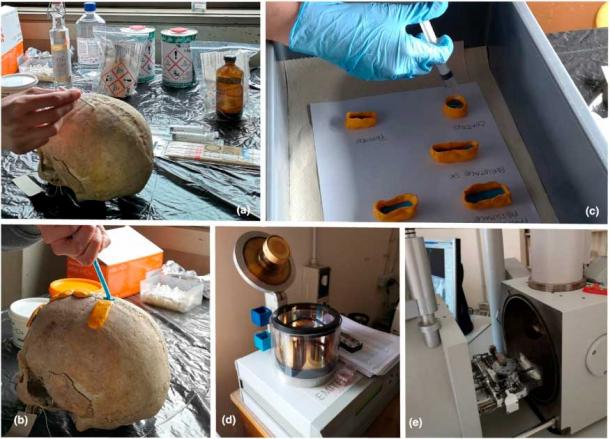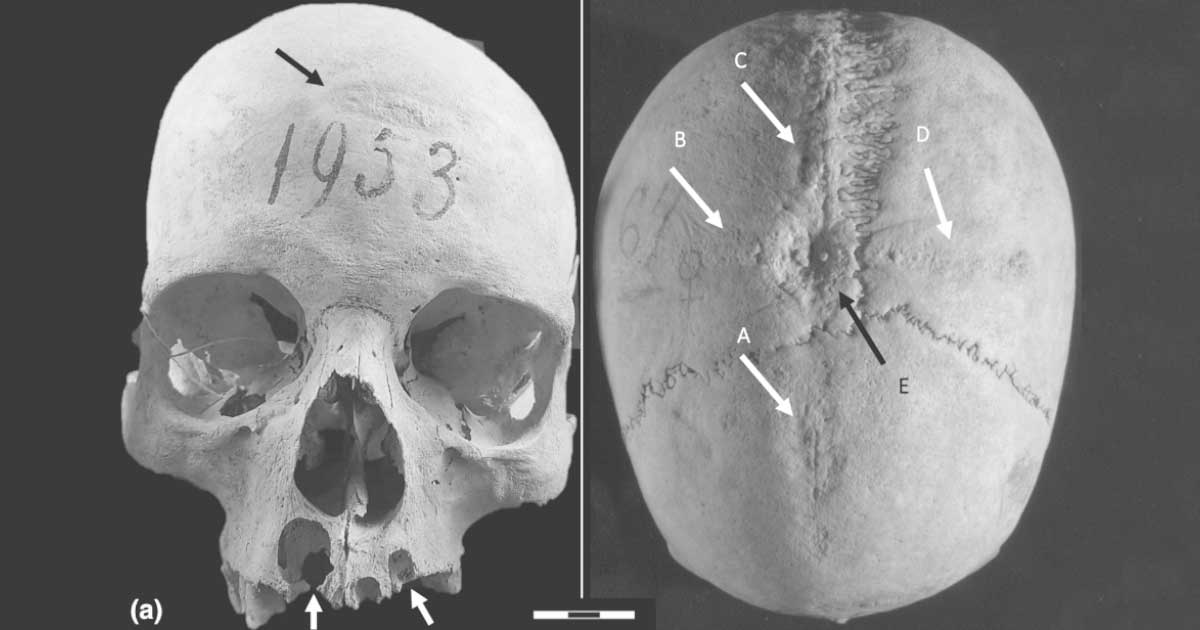Unfortunate Medieval Woman Underwent Surgery of the Skull—Twice!
A detailed examination of the skull of a woman who lived in central Italy in the medieval settlement of Castel Trosino more than 1,300 years ago has revealed something both astonishing and unprecedented. It seems this middle-aged woman from the Middle Ages had been subjected to not one but two invasive surgical procedures, which left tell-tale scars on the frontal and upper areas of her cranium.
First Evidence of Brain Surgery from the Region
The woman’s well-preserved skull was examined by a team of experts from Italy, Spain, France and the United Kingdom, under the supervision of paleoanthropologist Giorgio Manzi from Sapienza University in Rome. The scientists have just published the results of their study in the International Journal of Osteoarchaeology, a peer-reviewed publication that supports the use of advanced science and technology to resolve archaeological riddles relating to health.
“Among the tombs excavated, the skull of an older female shows the first evidence of a cross-shaped bone modification on a living subject,” the study authors wrote in their journal article.
“Macroscopic, microscopic, and CT scan analyses revealed signs of at least two sets of scraping marks. Specifically, SEM analysis shows that perimortem [before death] bone-scraping traces are present on the skull. Both healed and non-healed defects suggest that the woman has received at least twice intentional bone modifications to address her condition.”
These scrapings on the cranial bone were likely administered as a part of a treatment for a condition of the head or brain, which may have caused the woman a lot of pain or possibly resulted in psychological or behavioral difficulties.
- New Study Reveals that London was the Most Violent Place in Medieval England
- ‘Oldest’ British Skull Revealed to be Decapitated Woman from Norman Conquest

Molding and casting process of skull CT1953 which included evidence of medieval brain surgery. (Ileana Micarelli et al / Wiley)
Medieval Surgical Techniques Revealed By Modern Science
The Longobard Necropolis, as the medieval cemetery at Castel Trosino has been labeled, was first excavated in the 19th century. At that time hundreds of tombs were opened, and over the years the skeletal remains and collections of grave goods recovered have been intensively studied.
Unfortunately, only 19 skulls were found in good enough shape to be examined. As the technology has improved, archaeologists, anthropologists and other researchers have continued to look closely at these Early Medieval Period remains, trying to learn as much as they could about the health, physical characteristics and lifestyles of the residents of central Italy between 568 and 774 AD, when the necropolis was in use.
The researchers involved in this new study used all the tools for macroscopic and microscopic analysis at their disposal, and were able to show that the woman’s skull had been subjected to medical procedures, which is why it had scars and deformations.
The specific surgical techniques used involved the scraping of bone from the cranium as part of a medical treatment known as trepanation. This form of treatment was in fact discussed in European medieval literature, and some records of it go back even farther than that. But this is the very first time that scientists have been able to prove that an Early Medieval skull had been subjected to these risky procedures.
Trepanation is an extremely ancient form of treatment for head injuries, brain injuries, chronic headaches and behavioral issues. The most common type of trepanation recommends the drilling, cutting and removal and a circular section of skull bone from the cranium. This was supposedly done to relieve pressure in the head and brain.
In the case of the woman from the central Italian, Byzantine-era cemetery, the physicians responsible for her treatment used different or additional techniques. The researchers found a well-healed hole in the center of the cross-shaped scapings, which suggests they may have cut the cross out first as a way to better prepare the skull for the traditional surgical procedure.
Trepanation: Thousands of Years Old and Still Going Strong
While the woman’s skull has offered the oldest recovered evidence of the specific procedures identified, it is not the first skull that revealed the use of trepanation as a medical treatment.
The very earliest evidence of trepanation on human skulls comes from the Mesolithic period, which in Europe covered the years between 13,000 and 3,000 BC. The legendary ancient Greek physician Hippocrates, who inspired the Hippocratic oath that made doctors promise to do no harm to their patients, was using trepanation in the fifth century BC, while also teaching the technique to his medical students.
- Drilling Holes in the Skull was Never a Migraine Cure
- Trephination: The Oldest Evidenced Surgery Still in Use Today?
As for the use of the techniques identified during this new study, scraping of the skull for trepanation was first referenced by the first-century Roman scholar Celsus. One of history’s greatest medical chroniclers, Celsus took it upon himself to collect and publish a massive encyclopedia identifying all known medical procedures in the world at the time he lived (only a portion of his encyclopedia has been recovered, including the part that references trepanation).
During Byzantine times, the practice was written about by the seventh-century Greek Byzantine physician Paul of Aegina. Notably, Paul was the first to mention cross-shaped skull shaping as a trepanation technique, which shows that the procedure almost certainly would have been in use just a century or so earlier, when the woman buried at the Longobard Necropolis in Castel Trosino might have lived.
Amazingly, trepanation is still in use today, although not as a form of therapy. Now known by the more scientific-sounding name of ‘craniotomy,’ this method is used as a diagnostic or information-gathering tool, in cases where someone is suffering from conditions like brain lesions or a brain tumor and doctors are uncertain how to proceed.
Lucky Longobard Elites Had Access to the Top Medical Treatments
The Longobards were a Germanic tribe of Lombard people who first attacked but then later allied with the leaders of the Byzantine Empire. The Longobards began settling in central Italy around Castel Trosino in the sixth century, likely at the behest of the Byzantine rulers, who sought to occupy central Italy and make peace with the inhabitants to secure the outer flanks of their empire.
Once they’d built a fully-functioning community, the Longobard elites who’d led the migration to central Italy established the Kingdom of the Lombards, which ruled the area from 568 to 774. The Longobard Necropolis at Castel Trosino was reserved for the aristocrats of this ruling culture, as was revealed by the rich and impressive collections of grave goods found in their tombs.
In the tomb of the middle-aged woman, who was estimated to be about 50 years old at the time of her death, archaeologists discovered some expensive and finely-crafted items, including gold filaments and a bronze brooch and comb. She shared a tomb with a man, who presumably would have been her spouse.
As one of the apparent perks of her wealth and position, it seems the woman had access to what at the time would have been considered the finest in medical care.
"The last surgical intervention seems to have taken place shortly before her death,” study coordinater Giorgio Manzi confirmed in an interview with the Ansa Agency. “There are no injuries that could suggest the presence of trauma, tumors, congenital diseases or other pathologies. It is intriguing to consider the possibility of a ritual or judicial reason for these operations, but at the moment we have no evidence to support these hypotheses."
Given how trepanation was used in ancient and medieval times, the most likely answer is that the woman did indeed suffer from a frightening condition of the head or brain, and the best doctors at the time used the only treatment method they knew to address her issues.
Top image: Skull of a medieval woman showing evidence of brain surgery. Source: Divulgação/Universidade Sapienza
By Nathan Falde

















